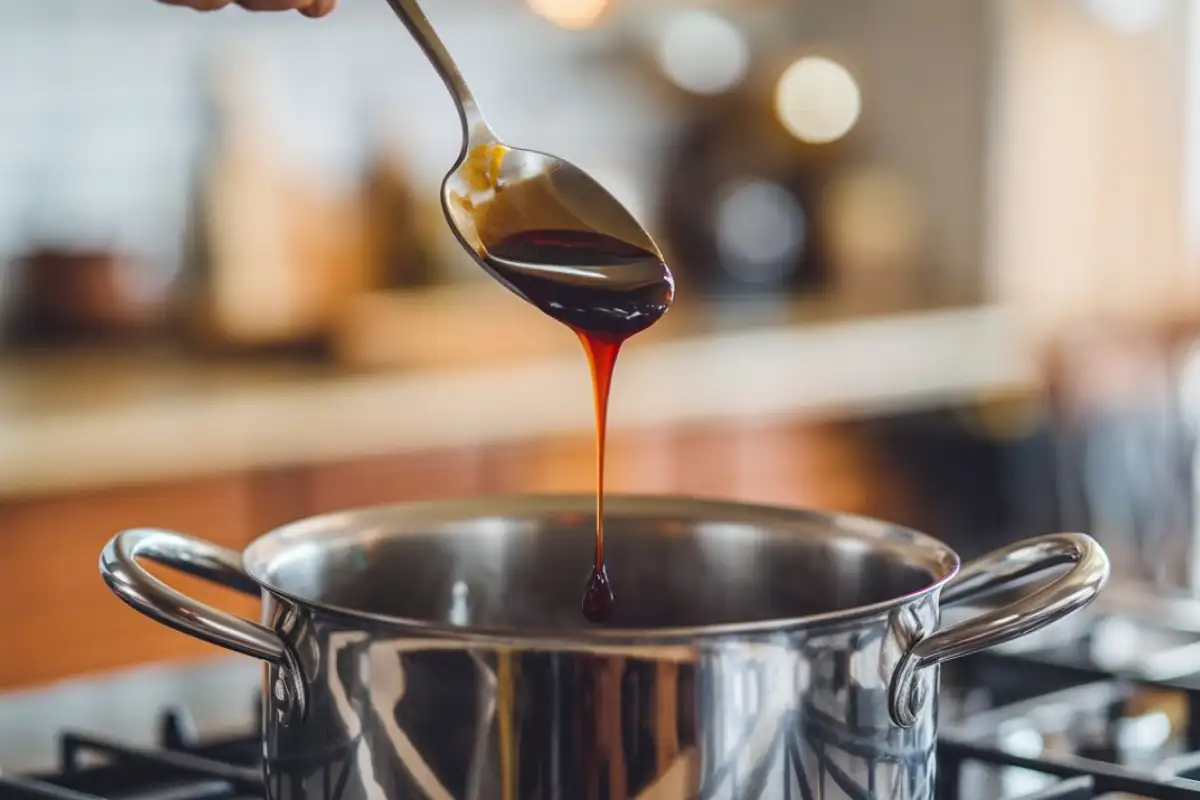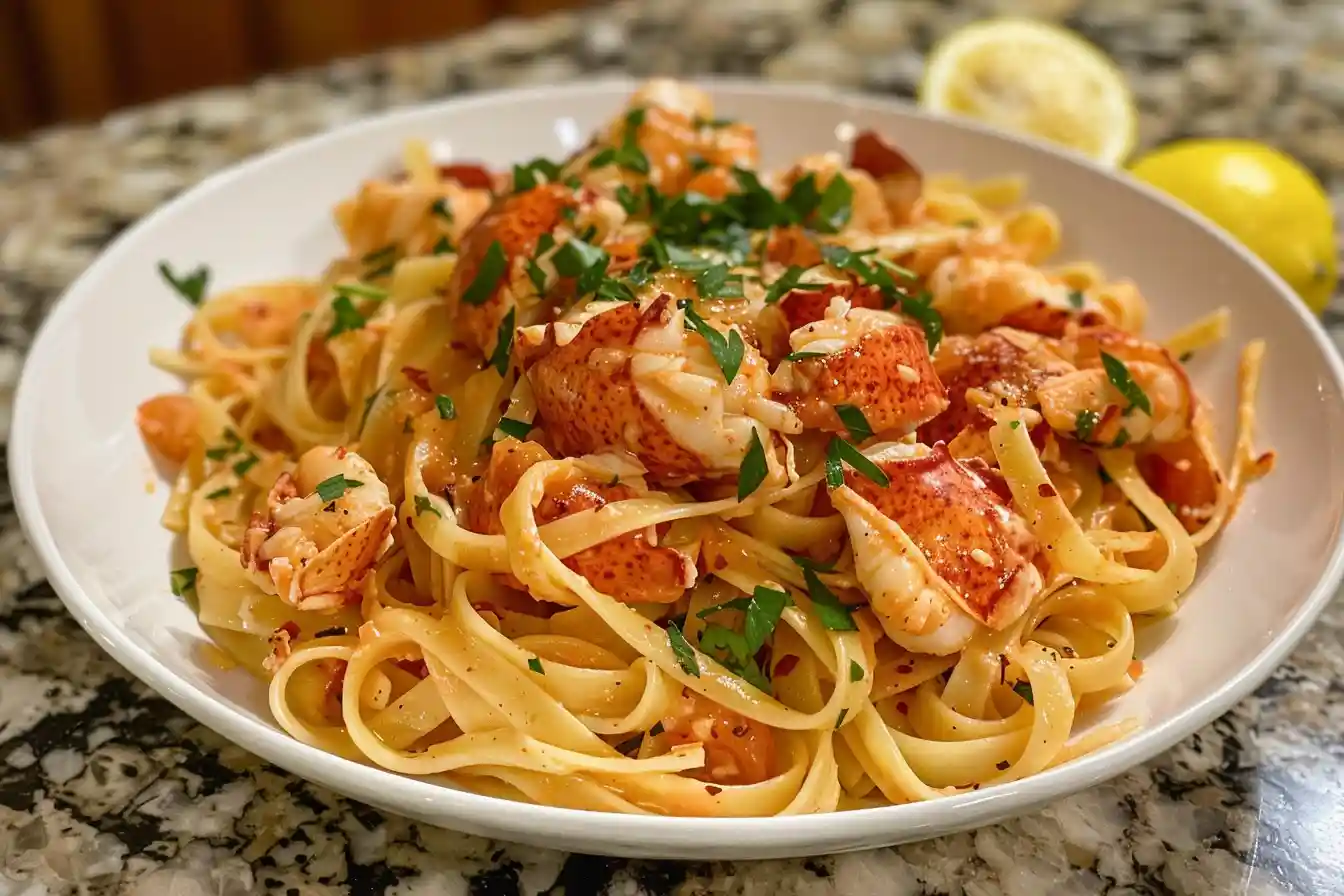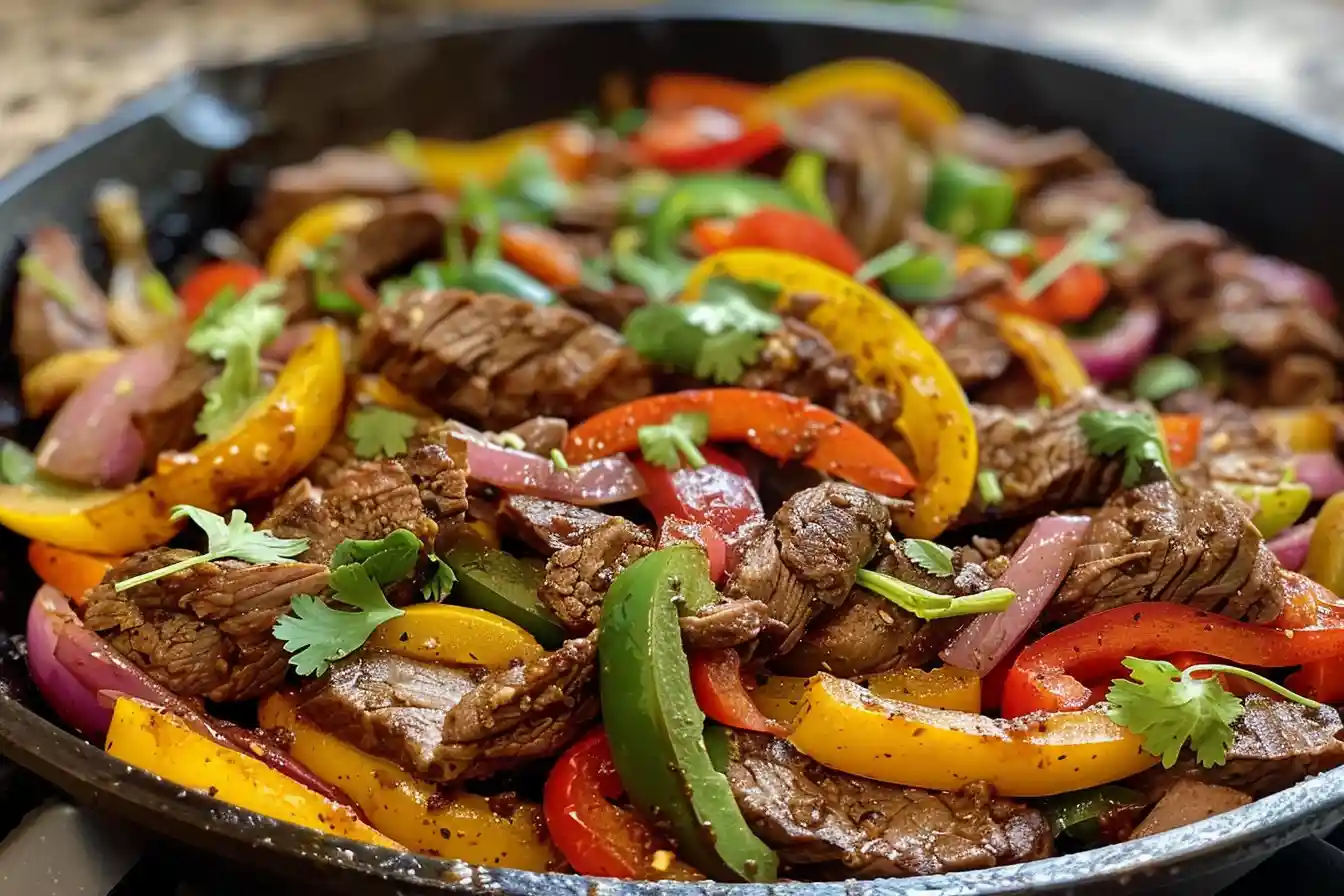What sweet soy glaze is made of? has transformed it into a beloved staple in kitchens around the world. This versatile, glossy sauce, with its rich, savory-sweet flavor, elevates a wide array of dishes. Whether serving as a marinade, a finishing glaze, or a dipping sauce, sweet soy glaze significantly enhances the depth of flavor in both Asian and Western cuisines.
Definition and Overview
Sweet soy glaze is a thick, syrupy sauce that combines the salty umami of soy sauce with the sweetness of sugar or other sweeteners. The balance of sweet and savory makes it an excellent accompaniment to meats, vegetables, and even some desserts. Whether drizzled over grilled chicken, mixed into stir-fries, or served as a dipping sauce, sweet soy glaze enhances the overall flavor profile of any dish it touches.
Popularity in Various Cuisines
Originally rooted in Asian cooking, particularly in Indonesian and Chinese cuisines, sweet soy glaze has transcended cultural boundaries. Today, it’s used globally, not just in traditional Asian dishes but also in innovative fusion cuisines. Its adaptability and the fact that it can be made with easily accessible ingredients have contributed to its widespread popularity.
Purpose of the Article
In this article, we’ll explore the composition of sweet soy glaze, its historical background, variations, and how you can make it at home. We’ll also delve into its nutritional aspects and provide some creative ideas for incorporating it into your cooking. Finally, we’ll address some frequently asked questions to give you a comprehensive understanding of this delicious condiment.
Historical Background of Sweet Soy Glaze
Origin of Sweet Soy Glaze
Sweet soy glaze has its roots in Asian culinary traditions, where the use of soy sauce as a base for various condiments is widespread. The specific origin of sweet soy glaze is closely linked to Indonesian cuisine, where it is known as Kecap Manis. Kecap Manis, a thick, sweet soy sauce, is a staple in Indonesian kitchens and is used in a wide range of dishes from marinades to dipping sauces.
Evolution Over Time
Over time, sweet soy glaze has evolved as it spread to different cultures. Each region has adapted the basic recipe to suit local tastes and available ingredients. For instance, Japanese cuisine offers a similar sauce called Teriyaki, which is slightly less sweet but shares many characteristics with sweet soy glaze. In Western cuisine, the sauce has been adapted into marinades, glazes, and dipping sauces for barbecues and roasts, making it a global favorite.
Primary Ingredients in Sweet Soy Glaze
The primary ingredients in sweet soy glaze are soy sauce, sweeteners, and aromatics or flavor enhancers. The specific combination and proportions of these ingredients can vary, but the result is always a rich, savory-sweet glaze.
Soy Sauce
Varieties of Soy Sauce Used
Soy sauce is the backbone of sweet soy glaze, providing the salty umami flavor that balances the sweetness. Different types of soy sauce can be used, with the most common being light soy sauce and dark soy sauce.
- Light Soy Sauce: Offers a lighter, saltier flavor and is typically used for dishes where the sauce is meant to be more prominent.
- Dark Soy Sauce: Has a richer, slightly sweeter flavor and is used to add depth and color to the glaze.
Role of Soy Sauce in the Glaze
Soy sauce in sweet soy glaze serves as the primary source of savory umami. It balances the sweetness provided by the other ingredients and helps create a complex flavor profile that enhances a wide variety of dishes.
Sweeteners
Sugar
The most common sweetener in sweet soy glaze is sugar. Different types of sugar can be used, each imparting a slightly different flavor.
- Granulated Sugar: Provides a clean, straightforward sweetness.
- Brown Sugar: Adds a deeper, more caramel-like flavor due to its molasses content.
Honey
Honey can be used as a natural sweetener, adding both sweetness and a subtle floral note to the glaze. It also helps to thicken the sauce due to its viscosity.
Molasses
Molasses adds a robust, bittersweet flavor that can deepen the overall taste of the glaze. It’s often used in combination with other sweeteners to add complexity.
Other Alternative Sweeteners
For those looking for alternatives, maple syrup or agave nectar can be used. These natural sweeteners offer unique flavors that can subtly change the character of the glaze, making it a bit lighter or more aromatic.
Aromatics and Flavor Enhancers
Garlic
Garlic is often added to sweet soy glaze to enhance its flavor. It can be used fresh, providing a sharp, pungent taste, or as garlic powder for a milder, more even distribution of flavor.
Ginger
Ginger is another common aromatic that pairs well with soy sauce. Fresh ginger adds a spicy, zesty kick, while powdered ginger offers a subtler, more warming flavor.
Vinegar
Adding a small amount of vinegar, such as rice vinegar or mirin, helps to balance the sweetness with a touch of acidity. This not only enhances the flavor but also helps to preserve the glaze.

Common Variations of Sweet Soy Glaze
While the basic components of sweet soy glaze remain consistent, there are several regional variations that offer unique takes on this delicious sauce.
Indonesian Kecap Manis
Kecap Manis is the Indonesian version of sweet soy glaze and is the most well-known. It is typically sweeter and thicker than other variations, with a more pronounced molasses flavor. Kecap Manis is a key ingredient in many Indonesian dishes, including Nasi Goreng (fried rice) and Sate (grilled skewers).
Japanese Teriyaki Sauce
Teriyaki sauce is similar to sweet soy glaze but has a more balanced flavor, with less sweetness and a slightly thinner consistency. It often includes additional ingredients such as sake or mirin, which add a mild alcoholic flavor and extra depth.
Chinese Sweet Soy Sauce
In Chinese cuisine, sweet soy sauce is often used as a base for stir-fries and braises. It tends to be less sweet than Kecap Manis but richer in soy flavor. It is often combined with other seasonings like star anise or cloves to create complex, aromatic dishes.
How to Make Sweet Soy Glaze at Home
Making sweet soy glaze at home is simple and allows you to adjust the ingredients to suit your taste.
Basic Recipe
List of Ingredients
- 1 cup soy sauce (light or dark)
- 1/2 cup brown sugar (or granulated sugar)
- 2 tablespoons honey or molasses
- 2 cloves garlic, minced
- 1 tablespoon fresh ginger, minced
- 1 tablespoon rice vinegar or mirin
- Optional: 1 teaspoon cornstarch (for thickening)
Step-by-Step Preparation Method
- Combine Ingredients: In a small saucepan, combine the soy sauce, sugar, honey or molasses, garlic, ginger, and vinegar.
- Heat the Mixture: Place the saucepan over medium heat and stir the mixture until the sugar is fully dissolved.
- Simmer: Bring the mixture to a gentle simmer, then reduce the heat to low. Let it simmer for about 10-15 minutes, stirring occasionally, until the glaze thickens.
- Optional Thickening: If you prefer a thicker glaze, dissolve the cornstarch in a tablespoon of water and stir it into the simmering glaze. Cook for an additional 2-3 minutes until it reaches your desired consistency.
- Cool and Store: Remove the glaze from heat and let it cool. Store it in an airtight container in the refrigerator for up to two weeks.
Tips for Perfecting the Glaze
- Adjusting Sweetness and Saltiness: If the glaze is too sweet, add a bit more soy sauce or vinegar. If it’s too salty, add a bit more sugar or a dash of water to dilute the flavor.
- Achieving the Right Consistency: The longer you simmer the glaze, the thicker it will become. If it becomes too thick, you can thin it out with a little water or soy sauce.
- Storage Tips: Always store the glaze in a sealed container in the refrigerator. It will keep well for up to two weeks, but be sure to stir it before each use as the ingredients may settle.
Quick and Easy Recipe for Busy Cooks
For those short on time, a simplified version of sweet soy glaze can be made by combining equal parts soy sauce and honey, and heating them together until slightly thickened. This quick version works well in a pinch and still delivers a delicious flavor.
Nutritional Information and Health Considerations
Sweet soy glaze, while delicious, should be used in moderation due to its sugar content. However, it also offers some nutritional benefits when used wisely.
Calorie Count and Macronutrients
A typical serving of sweet soy glaze (about 1 tablespoon) contains approximately:
- Calories: 35-50 calories
- Fat: 0g
- Carbohydrates: 8-12g
- Protein: 1g
The exact nutritional content will vary depending on the specific ingredients used, particularly the type and amount of sweetener.
Dietary Considerations
Sweet soy glaze can be adapted to fit various dietary needs:
- Vegetarian/Vegan: Most sweet soy glazes are naturally vegan, especially if you use a plant-based sweetener like maple syrup or agave nectar.
- Gluten-Free: Use a gluten-free soy sauce (such as tamari) to make the glaze suitable for those with gluten sensitivities.
- Low-Sodium: Opt for a low-sodium soy sauce to reduce the salt content without sacrificing flavor.
Sugar Content and Health Implications
While sweet soy glaze is high in sugar, using it sparingly can still fit into a balanced diet. For those managing blood sugar levels, consider using a natural sweetener with a lower glycemic index, such as agave nectar or coconut sugar.
Uses of Sweet Soy Glaze in Cooking
Sweet soy glaze is incredibly versatile and can be used in a variety of ways in the kitchen.
As a Marinade
Sweet soy glaze makes an excellent marinade for meats and vegetables. The combination of sweet and savory flavors penetrates deeply into foods, making it ideal for grilling or roasting. Popular options include:
- Chicken: Sweet soy-glazed chicken is a favorite for barbecues and roasts.
- Beef: Use it to marinate beef skewers or steaks before grilling.
- Tofu and Vegetables: For a vegetarian option, marinate tofu, eggplant, or mushrooms in the glaze before grilling or baking.
As a Finishing Sauce
Use sweet soy glaze as a finishing sauce to add a final touch of flavor to cooked dishes. It works particularly well with:
- Grilled Meats: Drizzle over grilled chicken, pork, or beef for a glossy finish.
- Stir-Fries: Toss it with stir-fried vegetables and noodles for a quick and tasty meal.
- Roasted Vegetables: Add a touch of sweetness to roasted Brussels sprouts, carrots, or sweet potatoes.
As a Dipping Sauce
Sweet soy glaze can be served as a dipping sauce alongside appetizers such as:
- Spring Rolls: Dip fresh or fried spring rolls in sweet soy glaze for added flavor.
- Dumplings: Pair with dumplings or gyoza as an alternative to traditional soy-based dipping sauces.
- Fried Tofu: Use it as a dipping sauce for crispy fried tofu.
Creative Culinary Applications
Beyond traditional uses, sweet soy glaze can be used in more creative ways, such as:
- Drizzling Over Roasted Vegetables: Add a final touch to roasted vegetables by drizzling them with sweet soy glaze just before serving.
- In Salad Dressings: Mix a small amount of sweet soy glaze with vinegar and oil to create a unique, flavorful salad dressing.
- As a Dessert Topping: For an unexpected twist, try drizzling sweet soy glaze over vanilla ice cream or fresh fruit.

Cultural Significance and Global Influence
Sweet soy glaze holds a special place in many cultures, particularly in Asia, where it is used in a variety of traditional dishes.
Role in Asian Cuisine
In Asian cuisine, sweet soy glaze is an essential component of many beloved dishes. It is particularly important in:
- Indonesian Cuisine: Used in Nasi Goreng, Sate, and other traditional dishes.
- Chinese Cuisine: Key ingredient in certain braised dishes and stir-fries.
- Japanese Cuisine: Integral to Teriyaki dishes and other grilled meats.
Global Adaptation
As sweet soy glaze has spread globally, it has been adapted to fit various culinary traditions. In the West, it is often used in:
- Barbecues: As a glaze for meats or mixed into marinades.
- Fusion Cuisine: Combined with Western ingredients to create new and innovative dishes.
Fusion Cuisine Examples
Some popular fusion dishes that use sweet soy glaze include:
- Soy-Glazed Salmon: A combination of Asian flavors with Western cooking techniques.
- Sweet Soy Glazed Pork Ribs: A dish that blends American barbecue traditions with Asian flavors.
- Soy-Glazed Tofu Tacos: A fusion of Mexican and Asian cuisines, where sweet soy glaze adds a burst of flavor to vegetarian tacos.
Conclusion
In conclusion, sweet soy glaze stands out as a delicious and versatile condiment that masterfully blends the savory umami of soy sauce with the sweetness of various sweeteners. With its deep roots in Asian cuisine, this glaze has not only preserved its cultural heritage but has also evolved into a global favorite, enhancing dishes across countless culinary traditions.
For both seasoned chefs and home cooks, experimenting with sweet soy glaze can be a delightful journey. Its adaptability allows you to explore different ingredients and techniques, from creating mouthwatering marinades and finishing sauces to surprising dessert toppings.
The unique combination of flavors that sweet soy glaze offers makes it an essential addition to any kitchen. Its enduring appeal, both culturally and culinarily, ensures that this sauce will continue to enrich dishes with its depth and complexity for years to come.





